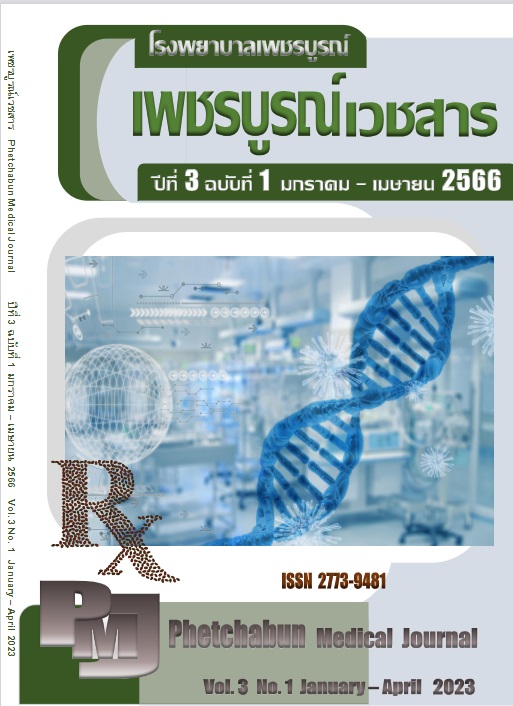Effect of the new normal medical service on glycemic control among type II diabetes patients
Abstract
The coronavirus disease 2019 (COVID-19) outbreak situation has affected health services to implement measures for preventing and spread of infection by avoiding overcrowding and social distancing. Therefore, the diabetes clinic of Phetchabun hospital, Klong Sala branch developed a service model for type 2 diabetes patients in accordance with the new medical service management approach that focuses on self-health management. This quasi-experimental research with 2 groups pretest and posttest design aimed to study the effect of the use of a new medical service management model on blood sugar control among type 2 diabetes
mellitus patients. The samples were 94 patients with type 2 diabetes receiving treatment at the diabetes clinic of Phetchabun hospital, Klong Sala branch, divided into 2 groups: an experimental group was 47 subjects who used the new medical service and a control group was 47 subjects who received regular medical appointments. The research tools consisted of a service management model according to the new normal medical approach, an assessment form for health literacy and self-management behavior according to 3E 2S principles, and a record form for clinical outcomes. The research was conducted and collected data during January-October 2022. Clinical outcomes were evaluated and followed up by patients in both groups for a period of 6 months.
Statistics used for data analysis consisted of frequency, percentage, mean, standard deviation, Fisher's Exact test, paired t-test, and independent t-test. The statistical significance level was set at 0.05.
The results showed that in type 2 diabetic patients who used the new normal medical service for a period of 6 months, the HbA1C was statistically significantly higher than before the experiment (7.1 %, 6.8%, p=0.011), but the health literacy score and health behavior scores according to 3E 2S were not different (p>0.05). For type 2 diabetic patients who follow up according to the regular pattern for 6 months, the HbA1C was higher than before the experiment statistically significant (7.2%, 6.9%, p=0.024), and also the score of health behavior according to 3E 2S was significantly lower than before the experiment (21.7, 23.9 points, p= 0.017),
but the health literacy score according to the 3E 2S principle was not different (p>0.055). Comparing the clinical outcomes after the 6 months period between the group using the new normal medical approach and the group receiving regular services, the health behavior scores according to 3E 2 S in the experimental group were significantly higher than the control group statistically significant (24.4, 21.7 points, p=0.002), but the fasting blood glucose (CBG), HbA1C, and health literacy scores according to 3E 2S were not different (p >0.05). In summary, the results of using the service management model according to the new normal medical approach in patients with type 2 diabetes promoted the improvement of health behavior according to the 3E 2S principle. herefore, it should be used in patient follow-up care for the benefit of reducing patient journey and expenses, and include reducing the number of patients and shortening the waiting time for patient services at the diabetes clinic

Downloads
Published
How to Cite
Issue
Section
License

This work is licensed under a Creative Commons Attribution-NonCommercial-NoDerivatives 4.0 International License.


